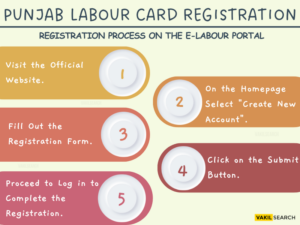The Punjab government has introduced an online e-portal for the registration of the Punjab Labour Card, enabling workers and employees throughout the state to easily register and obtain their Labour Card. This card provides access to various government schemes initiated by the state government, allowing workers in Punjab to receive the benefits of these programmes.
About Punjab Labour Card Registration 2023
The National Informatics Center (NIC) has developed a dedicated online portal aimed at promoting labour laws, safety, and the welfare of workers. This e-labour portal will provide online services to workers throughout the state of Punjab. To avail of the benefits offered by the Punjab government on this portal, all employees in the state must register on the portal. Once registered, all facilities available on this portal will be accessible to registered workers and employees. Additionally, benefits will be directly transferred to the bank accounts of registered employees and workers in the state, ensuring they do not encounter any difficulties.
Goal of Punjab Labour Card Registration
Prior to the launch of this online portal, workers in Punjab were required to physically visit government offices to obtain their labour cards, often encountering various issues that consumed a significant amount of time. To address these challenges, the state government has introduced an official website called the e-portal for labourers. This online portal enables labour employees in Punjab to easily register and acquire their labour cards, saving them time and eliminating the need to visit government offices. In addition to enhancing convenience, the e-portal for labourers is designed to provide various benefits to workers in Punjab.
Benefits of Punjab E Labour Portal
- The e-portal offers a range of features, including online registration, a dynamic Common Application Form (CAF) for online application submission, one-time document submission, an online payment gateway, and online processing.
- Additionally, the e-portal provides various facilities, including the ability to view and download inspection reports, file annual returns, submit labour welfare contributions through an online payment gateway, self-certification scheme, and register factory and labour wings, among others.
- The benefits offered by the Punjab State labour Welfare Board Department under various welfare schemes will be directly deposited into the bank accounts of labour employees in Punjab through this portal.
- It is important to note that only labour employees of Punjab are eligible to apply for the Punjab E labour Portal; this portal is not for other individuals.
- By introducing this portal, the government aims to save people’s time and prevent them from visiting multiple government offices.
Advantages of Schemes Provided Through Punjab Labour Card
- Under the Stipend Scheme, children of registered construction workers in Punjab are eligible to receive a yearly stipend ranging from ₹3,000 to ₹70,000, depending on their academic level from 1st class to degree courses.
- The Shagun Scheme offers financial assistance of ₹31,000 for the marriage of two daughters of registered construction workers. If the daughter is a registered member herself, she will be entitled to receive the Shagun amount for her marriage.
- In case of the death of a registered construction worker or their family member, the Funeral Assistance Scheme provides financial assistance of ₹20,000 for expenses related to funerals and last rites in the state of Punjab.
- The Cycle Scheme for Children of Construction Workers provides a one-time free cycle to children of registered construction workers who are studying in the 9th to 12th grade in Punjab.
- Furthermore, the board provides financial assistance of ₹20,000 per annum for the care of mentally challenged or handicapped children of construction workers.
What is the Process for Registering for Punjab Labour Card Registration on the e-Labour Portal?

To register for Punjab labour Card on the e-Labour Portal, the applicant needs to visit the portal’s official website and access the home page. On the home page, they should select the option to create a new account, which will direct them to a registration form. The form will require them to provide details such as their username, last name, email address, mobile number, and captcha code. After filling out the form, they should click on the submit button and proceed to log in using their username and password to complete the registration process.
Feedback Process in e-Labour Portal
- To begin with, the initial step is to visit the official website.
- Once you reach the website, the homepage will be displayed.
- On the homepage, there will be a section named Feedback.
- You need to select this option.
- After selecting the Feedback option, you will be redirected to the next page where you will find a form.
- In the form, you will be required to provide certain details such as department type, email id, mobile number, name, industry name, and subject state, among others.
- Once you have provided all the information, you can submit the feedback by clicking on the submit button.
Contact Details
To access the contact details, you need to first visit the official website. Once you’re on the home page, look for the Contact us option and click on it. This will direct you to a new page where you can find all the necessary contact information, including phone numbers.
For any clarifications or any information regarding the Punjab e-labour card, please contact our Vakilsearch experts.
Conclusion
The Punjab Labour Card Registration is a commendable initiative by the state government that aims to empower workers and provide them with social security benefits. The scheme offers a range of benefits, including fair wages, access to government schemes, and training and skill development. The labour card is a valuable tool for workers, providing them with easy access to credit and enabling them to improve their lives. We encourage all eligible workers to register for the Punjab Labour Card and take advantage of this great initiative.
Read More,



